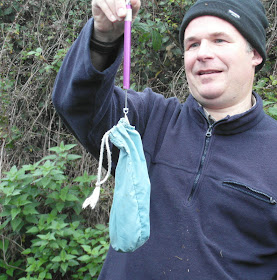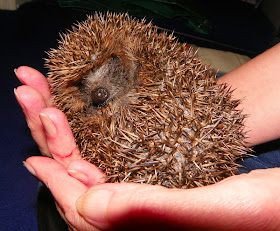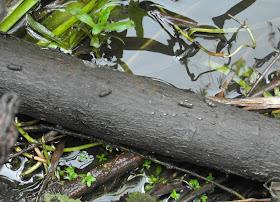Saturday, 29 December 2012
Traffic
A peep under the bridge at White Lion Meadow (the main town car park by Tesco) reveals a lot of rodent activity under the bridge. There are certainly rat prints here, and mouse, but I'm moderately confident that some of these are water vole because of their starry shape. The two pawprints directly under the twig in the centre of the second photo look likely, for example.
The banks on this stretch of the brook are deep enough to keep the voles safe even if the water level rises a few feet, as long as they stay in their burrows and don't try to swim in the strong current.
Sunday, 23 December 2012
Happy Christmas to Volers Everywhere
We're in the dead zone now as regards vole-watching. I don't expect to see much in the way of field signs till February, and no actual sightings of animals till the end of that month or even March/April. I worry, too, about the amount of rain that's come down lately, in case some of the burrows have been compromised and the voles made vulnerable.
However, we've had very wet winters before and the colonies always do seem to come back, so I'm just crossing my fingers as usual and counting the days till the spring. We're not too far away now.
In the meantime, let me direct you to Terry Whittaker's gorgeous blog, and remind you that his water vole photography workshops will be running in 2013.
http://terrywhittakerphoto.blogspot.co.uk/2012/12/water-vole-workshops-2012.html
However, we've had very wet winters before and the colonies always do seem to come back, so I'm just crossing my fingers as usual and counting the days till the spring. We're not too far away now.
In the meantime, let me direct you to Terry Whittaker's gorgeous blog, and remind you that his water vole photography workshops will be running in 2013.
http://terrywhittakerphoto.blogspot.co.uk/2012/12/water-vole-workshops-2012.html
Saturday, 17 November 2012
The Field Studies Council
Common shrew jawbones. The enamel at the very tips of the teeth is red.
Badger hair: white at the tip, ridged when you roll it between your fingers.
Weighing one of the mammals we trapped.
The Longworth traps are opened inside a bag so the animal doesn't leap away and escape.
Shrew in motion.
I think, going by tail length, we decided this was a pygmy shrew.
Bank vole.
Wood mouse. Scruffing small rodents is the best way to hold them; picking up a wood mouse by its tail can cause the skin to shear away painfully and permanently.
I was lucky enough to attend a Field Studies Centre course this autumn on mammal identification. The FSC run training courses for both amateur and professional ecologists, and cover a wide range of wildlife topics across their various schools: http://www.field-studies-council.org/ My course was at Preston Montford in Shropshire.
We were taught to prepare and set small-mammal traps, the correct way to check them and the proper way to handle and record the wild rodents we caught. We were also shown how to clean the traps after use. We looked at animal prints, nests, skin markings, scat, skulls and feeding signs, and listened to some common mammal calls. We looked at recording and reporting methods; we dissected owl pellets. At the end of the three-day residential course, students were invited to take an exam in Mammal Identification.
I'm delighted to say my certificate came this week and I got a Distinction, with 60 marks out of a maximum 64. So I'm very pleased because I enjoyed the course so much. Now I'm off to join the Mammal Society! http://www.mammal.org.uk/
Saturday, 10 November 2012
Foster Hedgehog
Wildlife rescue centres around the country are currently inundated with juvenile hedgehogs who need carers to feed them up to 600g, a safe weight for hibernation. I took myself down to the West Midlands centre and brought back two small hogs, one for myself and one for Lorcan from the Whitchurch Water Vole group.
We've been told to keep our hedgehogs warm and to feed them meaty (not fishy) cat food (in jelly, not gravy). A saucer of cat biscuits also goes down a treat, and they need plenty of fresh water to drink (never milk).We're weighing them every day or two, handling as little as possible, and when they attain their ideal mass we can put them in an outdoor sheltered place, like a shed or a garage, with a box or hutch from which they can come and go, plus food and fresh water. The hope is that the cold temperatures then will trigger hibernation, though the animals will still need to be checked every day and supplies renewed. Come the spring they can then be released into the wild.
Lorcan's blog charts our progress here: http://www.younghog.blogspot.co.uk/ My hog had a poor start as he had to be taken to the vet and wormed, but since then he's picked up strongly. Lorcan's female hog goes from strength to strength.
If you have a spare room and an unused hutch and think you could foster a small hedgehog, do google your local wildlife rescue centre because I know they'd appreciate any help they can get!
Thursday, 18 October 2012
BBC Wildlife Magazine
Hello to new readers!
Cover-vole
Me, waiting for voles.
I'm the chapter on water voles in Hugh Warwick's gorgeous book about wildlife advocates.
Before She Was Mine: the only novel you're likely to read this year which tells you how to set up a mink raft.
*
I am thrilled to report that my own Whitchurch water voles form a seven-page feature in the November edition of BBC Wildlife Magazine (out today!). I write about what happens to water voles in the winter, and the article is complemented by the most beautiful photographs from Terry Whittaker, Jules Cox, Ben Hall, John Harding, Roger Wilmshurt, Simon Booth, Simon Colmer and Dennis Lorenz, as well as one I took of a vole chewing my boot.If you're coming to this blog for the first time, welcome, and please check out my photos of field signs - use the labels on the right to pull out whichever sort you're interested in.
You can hear me talking about water voles on Radio 4's 'Saving Species' here, 16 minutes in: http://www.bbc.co.uk/programmes/b014fd21
and here on one of Hugh Warwick's wildlife podcasts: http://www.urchin.info/podcasts/
You can watch my videos of voles and hedgehogs on my Youtube channel here: http://www.youtube.com/user/HarvyCola?feature=mhee
Come and say hello to me on Twitter: https://twitter.com/volewriter
and if you want to check out my books, I'm here: http://www.katelong.co.uk/
Lastly, this blog is fairly quiet during the colder months, like the voles it follows, but come spring there will be posts every few days as I follow the progress of my local colonies and record their activities over 2013.
Tuesday, 2 October 2012
Activity - if you look for it
We still have at least two hedgehogs coming into the garden, one on the early shift and one on the late. Early hog is smaller, but still a decent-sized adult.
Meanwhile a quick peep at the back of Saddler's Walk (Mossfields) shows the ditch to be full and healthy - rainy summers benefit this colony as the site easily dries out. This group of voles is notable for the number of feeding stations it always produces, always a lot more than other sites I survey. Though with the colder weather most water voles switch their diet to more calorific tubers and roots, these ones are still making piles of chopped sweet rush well into October. In the bottom photo, the vole has bent the blade down, folded it in half and made the usual diagonal cut, which then opened to make a point (would have been a V if the cut had been made from the other side).
Saturday, 22 September 2012
Holing Up for the Winter
Great crested and common baby newts at Brown Moss
Water vole droppings
Blocked up burrow
It's more or less time to say goodbye to the voles for this year - I did spot one briefly this morning, but mostly they're packing away in preparation for the winter. They'll be storing high-calorie tubers and blocking up strategic burrow entrances, as in the photo above. Very little sign of feeding, except for gnawed iris roots, but are still plenty of droppings about, so I know the voles are around.
Looking forward to speaking at Walford College's Bioblitz this afternoon with Rosie Rees and Lorcan Adrian, stressing the importance of reporting sightings and disseminating vole information between various parties - landowners, the EA, the council, water authorities, the WT etc - and also the need to protect wildlife corridors as well as individual colonies themselves.
Wednesday, 12 September 2012
Water Vole Heroes
I've lately been doing some research for a magazine article, and also for a talk at Walford College's Bioblotz
http://www.bnhc.org.uk/home/bioblitz/national-bioblitz/midlands/walford-college-bioblitz-shropshire.html
and it's struck me just how many people are working hard nationwide to save the water vole.
I've lost count of the folk who track and log these animals, who lobby their council planning departments, who travel the country taking wonderful photographs to raise the species' profile. This year I've met up with Richard Steel (link to his website is on the right); with Vicky Nall and team at the Cheshire Wildlife Trust; with Gareth Parry who's studying the effect of carnivores on vole populations; and with John Harding and Rosie Rees who've been putting together a film about water vole behaviour. The Whitchurch Water Vole group led by Malcolm Monie continue to do vital habitat management and survey work, and online I've been following vole news from Views of the Ock (link right) and Jo Cartmell, amongst others. There's a substantial network of men and women doing their best to halt the decline of the species and help build up numbers again.
But three people I've come across lately deserve a special mention for the good they do. The first is Rob Strachan, who currently works for the environment agency and co-authored what I believe is the definitive guide to water vole mitigation, The Water Vole Conservation Handbook. He also gives excellent talks and is a mine of information on riparian wildlife generally.
Secondly there's Derek Gow, a man who actually farms water voles: http://www.watervoles.com/ He offers training days to help with issues like translocation when voles need saving from building developments, and he provides voles for release when conservationists are trying to re-stock sites where those animals once were. To say he loves his work would be an understatement.
And lastly, Professor Xavier Lambin of Aberdeen university, who's been in the news this week with his findings of water vole dispersal models: http://www.bbc.co.uk/news/science-environment-19503827 Once again his investigations underline the need to preserve wildlife corridors as well as individual colonies themselves, and avoid habitat fragmentation.
It's good to have so many on the case, volunteers and professionals at all levels. Given the problems water voles face at the moment, they need all the allies as they can get.
Thursday, 6 September 2012
Change of Behaviour with the Seasons
I'm already noticing a change in the way the voles are feeding, and moving about generally. Just a month ago they were happy to swim about openly in front of my camera and sit and eat just by my feet. Now they're dashing past at speed underwater, and the two I saw feeding tonight were working from the safety of tunnels, occasionally putting out their noses but that was all. I suspect it's to do with population density which is thinning out now the voles are dispersing to new sites. I know there are still plenty of animals about - the banks are still volescaped and there are lots of fresh droppings and tidy burrows, prints and chopped or grazed vegetation. These signs will gradually disappear, though, as autumn progresses.
The practical upshot for this blog is that I don't think I'll be getting many more photos; the pictures of voles at the top are some of John Harding's, taken earlier this year. However, as I usually do, I'll be keeping an eye on this colony and the others over the winter and cataloguing the first field signs as they appear in spring. In general it's not been a bad year for water voles in Whitchurch, mainly because we don't experience the severe flooding many other sites have had across the country, and because we've managed to keep the mink out for another season. Long may it continue!
Tuesday, 28 August 2012
Tailing off
Latrine
Prints
I'm getting fewer sightings now, even though it's not even September. Tempting to start worrying about the impact of the polecat, but really I think it's just the usual autumn dispersal as, firstly, this is a pattern I've observed over the last six years and secondly, I'm still counting lots of freshly-attended latrines. It's possible the adults who were so forward a couple of weeks ago, climbing on my boot and investigating my bag, have been predated as I've not seen any sign of them for a while. But there are plenty of youngsters still about, including a very small vole not long out of the nest - I'm guessing not much older than five or six week at the most. As you can see from photo 5, he's only about the size of a nettle leaf.
Sunday, 26 August 2012
Native Predators
Polecat
Greenfields water vole survey: these tiny mud-coloured droppings (lower right) are what we're looking for
...and this is where we're looking, in amongst this vegetation. Needle in a haystack doesn't come close.
It's helpful when animals leave their scat on prominent places
as this Grindley Brook otter has done.
I was watching for water voles and seeing none when this polecat slunk past on the far bank. All mustelids will take a vole if they get the opportunity, and there are already weasels and otters recorded for this stretch. However I'm hoping the polecat doesn't impact too far on the Edgeley Road colony. There are good vole numbers here, at least.
Saturday, 18 August 2012
Life Expectancy
Much squabbling again tonight. The voles are dispersing, juveniles being driven off to find new territories by their parents, and it's a sobering thought that the adults I'm seeing around now are unlikely to make it through to the spring.
Water vole life expectancy is just five months, due to high predation of young (and, I imagine, nests being lost to floods). But even voles who make it to full size almost always die during their second winter. Late-born juveniles which are too small, less than 140g, will also fail to make it.
That's why these last weeks of summer are so precious, and the first sightings of the following year so joyful.



















































